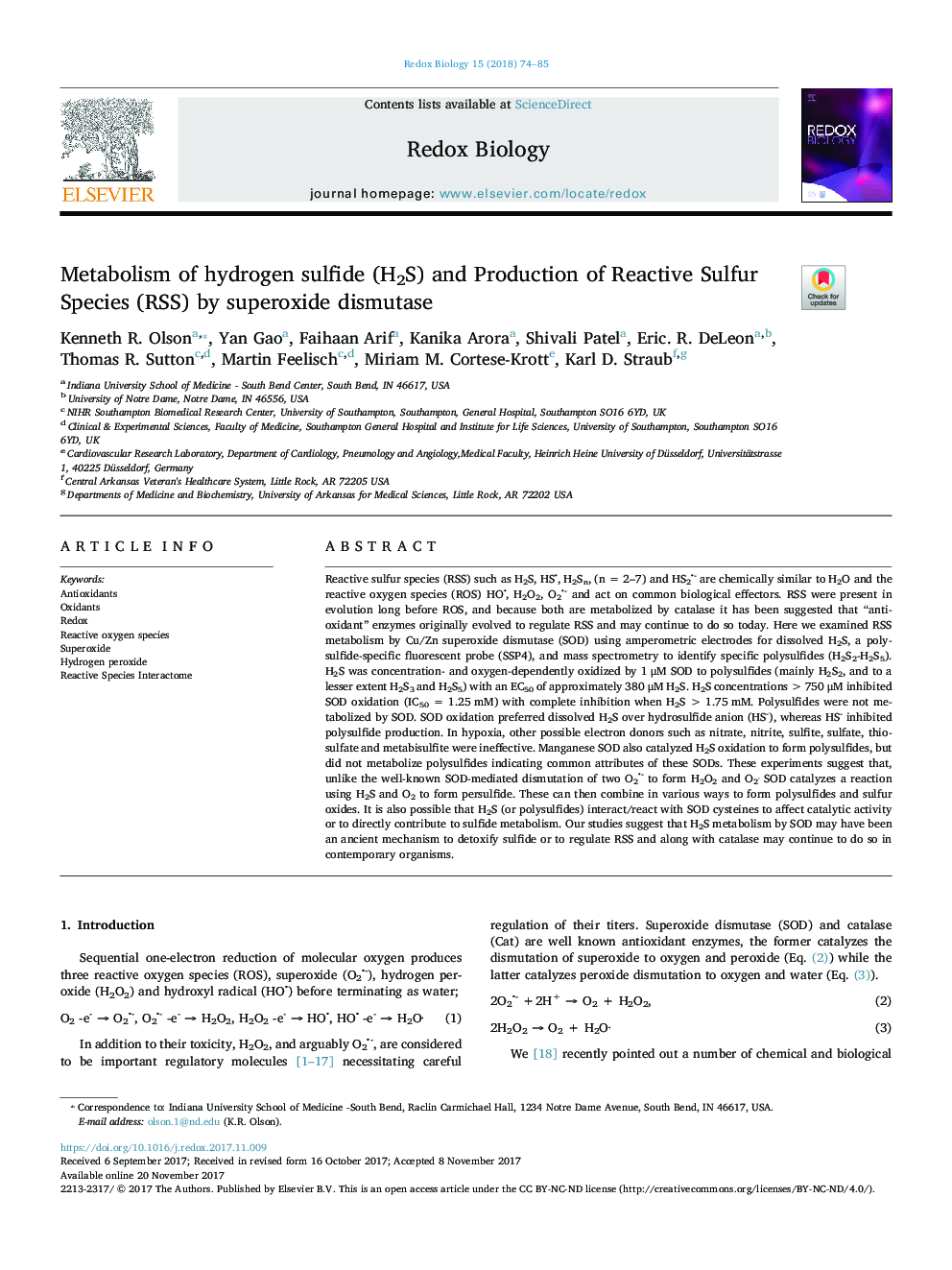| کد مقاله | کد نشریه | سال انتشار | مقاله انگلیسی | نسخه تمام متن |
|---|---|---|---|---|
| 8286539 | 1535835 | 2018 | 12 صفحه PDF | دانلود رایگان |
عنوان انگلیسی مقاله ISI
Metabolism of hydrogen sulfide (H2S) and Production of Reactive Sulfur Species (RSS) by superoxide dismutase
دانلود مقاله + سفارش ترجمه
دانلود مقاله ISI انگلیسی
رایگان برای ایرانیان
کلمات کلیدی
موضوعات مرتبط
علوم زیستی و بیوفناوری
بیوشیمی، ژنتیک و زیست شناسی مولکولی
سالمندی
پیش نمایش صفحه اول مقاله

چکیده انگلیسی
Reactive sulfur species (RSS) such as H2S, HS
- , H2Sn, (n = 2-7) and HS2
- - are chemically similar to H2O and the reactive oxygen species (ROS) HO
- , H2O2, O2
- - and act on common biological effectors. RSS were present in evolution long before ROS, and because both are metabolized by catalase it has been suggested that “antioxidant” enzymes originally evolved to regulate RSS and may continue to do so today. Here we examined RSS metabolism by Cu/Zn superoxide dismutase (SOD) using amperometric electrodes for dissolved H2S, a polysulfide-specific fluorescent probe (SSP4), and mass spectrometry to identify specific polysulfides (H2S2-H2S5). H2S was concentration- and oxygen-dependently oxidized by 1 μM SOD to polysulfides (mainly H2S2, and to a lesser extent H2S3 and H2S5) with an EC50 of approximately 380 μM H2S. H2S concentrations > 750 μM inhibited SOD oxidation (IC50 = 1.25 mM) with complete inhibition when H2S > 1.75 mM. Polysulfides were not metabolized by SOD. SOD oxidation preferred dissolved H2S over hydrosulfide anion (HS-), whereas HS- inhibited polysulfide production. In hypoxia, other possible electron donors such as nitrate, nitrite, sulfite, sulfate, thiosulfate and metabisulfite were ineffective. Manganese SOD also catalyzed H2S oxidation to form polysulfides, but did not metabolize polysulfides indicating common attributes of these SODs. These experiments suggest that, unlike the well-known SOD-mediated dismutation of two O2
- - to form H2O2 and O2, SOD catalyzes a reaction using H2S and O2 to form persulfide. These can then combine in various ways to form polysulfides and sulfur oxides. It is also possible that H2S (or polysulfides) interact/react with SOD cysteines to affect catalytic activity or to directly contribute to sulfide metabolism. Our studies suggest that H2S metabolism by SOD may have been an ancient mechanism to detoxify sulfide or to regulate RSS and along with catalase may continue to do so in contemporary organisms.
- , H2Sn, (n = 2-7) and HS2
- - are chemically similar to H2O and the reactive oxygen species (ROS) HO
- , H2O2, O2
- - and act on common biological effectors. RSS were present in evolution long before ROS, and because both are metabolized by catalase it has been suggested that “antioxidant” enzymes originally evolved to regulate RSS and may continue to do so today. Here we examined RSS metabolism by Cu/Zn superoxide dismutase (SOD) using amperometric electrodes for dissolved H2S, a polysulfide-specific fluorescent probe (SSP4), and mass spectrometry to identify specific polysulfides (H2S2-H2S5). H2S was concentration- and oxygen-dependently oxidized by 1 μM SOD to polysulfides (mainly H2S2, and to a lesser extent H2S3 and H2S5) with an EC50 of approximately 380 μM H2S. H2S concentrations > 750 μM inhibited SOD oxidation (IC50 = 1.25 mM) with complete inhibition when H2S > 1.75 mM. Polysulfides were not metabolized by SOD. SOD oxidation preferred dissolved H2S over hydrosulfide anion (HS-), whereas HS- inhibited polysulfide production. In hypoxia, other possible electron donors such as nitrate, nitrite, sulfite, sulfate, thiosulfate and metabisulfite were ineffective. Manganese SOD also catalyzed H2S oxidation to form polysulfides, but did not metabolize polysulfides indicating common attributes of these SODs. These experiments suggest that, unlike the well-known SOD-mediated dismutation of two O2
- - to form H2O2 and O2, SOD catalyzes a reaction using H2S and O2 to form persulfide. These can then combine in various ways to form polysulfides and sulfur oxides. It is also possible that H2S (or polysulfides) interact/react with SOD cysteines to affect catalytic activity or to directly contribute to sulfide metabolism. Our studies suggest that H2S metabolism by SOD may have been an ancient mechanism to detoxify sulfide or to regulate RSS and along with catalase may continue to do so in contemporary organisms.
ناشر
Database: Elsevier - ScienceDirect (ساینس دایرکت)
Journal: Redox Biology - Volume 15, May 2018, Pages 74-85
Journal: Redox Biology - Volume 15, May 2018, Pages 74-85
نویسندگان
Kenneth R. Olson, Yan Gao, Faihaan Arif, Kanika Arora, Shivali Patel, Eric. R. DeLeon, Thomas R. Sutton, Martin Feelisch, Miriam M. Cortese-Krott, Karl D. Straub,